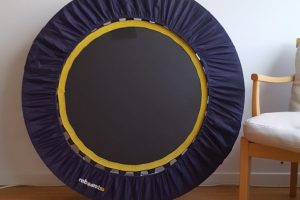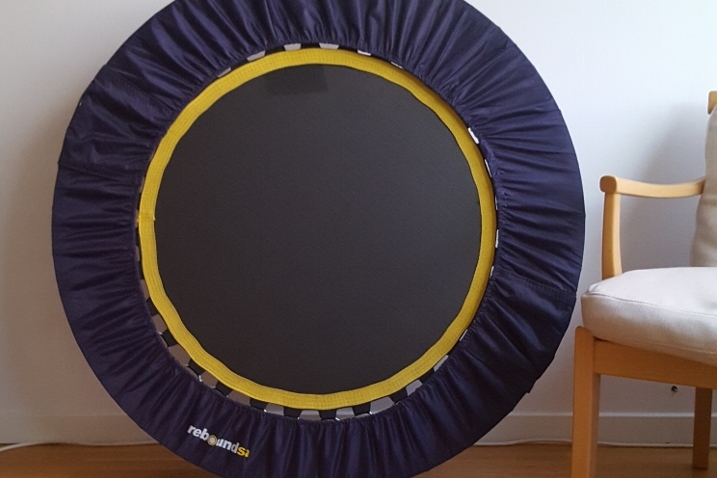 Say what? Rebounding is a form of exercise that is done on a small indoor trampoline. Urban Rebounding gained popularity in the 1980’s when a study commissioned by NASA found that athletes experienced greater benefits at a cellular level, with less impact on their bodies, doing rebounding as an exercise compared to running.
Say what? Rebounding is a form of exercise that is done on a small indoor trampoline. Urban Rebounding gained popularity in the 1980’s when a study commissioned by NASA found that athletes experienced greater benefits at a cellular level, with less impact on their bodies, doing rebounding as an exercise compared to running.
You might not believe it but the simple act of jumping around or running on a trampoline actually provide you certain powerful health benefits.
These include:
- Getting your lymphatic system going. This is a major benefit as your lymphatic system supports your immune system and transports immune cells through your body, as well as flushing out toxins, poisons and heavy metals.
- Giving you a good cardiovascular and core strengthening workout, leading to improved stability and balance, without added pressure on your joints.
- Increasing bone density and reducing your risk of osteoporosis.
- Improving your mental health.
- Giving you a fun & effective workout that you can start and complete in the same time that it takes you to get dressed and leave for the gym.
So, how do you do this thing called Rebounding?
I’ll start with a few tips.
- Firstly, try not wearing restrictive clothing to allow for better lymph flow.
- It is important to start slowly to improve your balance, especially if your balance is poor or you haven’t worked out in a while. In these instances, working out with a safety bar on your rebounder is advised.
- You can use hand weights to increase the effort and challenge of your workout.
- Try to keep engaging your core muscles, making sure there is energy in your body and limbs. No flopping around!
- I usually stick to a minimum of 20 minutes per session. If I am tied for time, I might do just 10 minutes to clear my head, but rarely less than this.
- There are exercise videos on Youtube and for sale out there that will give you work out sessions for your rebounder. These are a great way to get started and introduce you to the various exercises that can be done . It is also nice to follow an instructor as it takes the thinking out of it. Don’t let not having a workout video stop you though!
Here are a few examples of exercises that you can start with all on your own.
The Warm Up – This is done by jumping gently for a minute or so with your arms at your sides and, as you feel more balanced, you start raising and lowering your arms to the side and the front. You can also include hand-weights in the warm-up.
Twist – This one is great for the oblique muscles. It is done by keeping your head and shoulders facing forward as you jump, and rotating your lower body and hips from left to right, making sure both your feet land together simultaneously on the trampoline in alternate rotations from left to right.
Jumps – This is a good way to practice control of your body. Start with your feet placed shoulder width apart, arms at your sides and jumping up and down in a straight line.
Knee Lifts – This is done by raising one leg at a time while the opposite foot is on the rebounder, and making sure the knee of the raised leg is lifted slightly above that leg’s hip.
Jumping Jacks – On your first jump, start with your feet together and hands at your sides, and land with your feet shoulder width apart and arms at shoulder height.
On the second jump, bring your legs back together, engaging your inner thigh muscles, and bring your arms back down to your sides. This is then repeated, and can also be done with hand weights.
Skiing – Standing on the rebounder with feet shoulder width apart, you start by jumping side to side with your knees slightly bent. As you jump, alternate raising and lowering your arms so when you jump to the right your arms are straightened out horizontally in front of you and jumping to the left, your arms are straight next to your body.
Running – Run as if you are on the road.
High Intensity Interval Training (HIIT) – This is one of my favourite ways to work out on the rebounder. I usually start with 3 minutes running, and then do 8 repetitions of 30 seconds sprinting and 90 seconds running at a normal pace. I complete this with 1 minute warm-down, which in total gives me a 20 minute workout that improves my cardiovascular strength, burns fat and strengthens my core!
Convinced yet?
Personally, my rebounder is one of the happy places in our home. I absolutely love it for the following reasons –
- If at any time I have lower back pain, due to sleeping in an incorrect position or picking up something too heavy, 20 minutes on my rebounder sorts it out EVERY SINGLE TIME
- When I’m feeling foggy or grouchy, if I didn’t get enough sleep or blood sugar is low – again 20 minutes on the rebounder, clears my head!
- And then, I am an absolute sucker for anything that is effective, practical and sustainable and fits into my daily life. Rebounding is 100% this! It is a fun, easy, affordable and accessible addition to any workout routine, whether it be pilates or strenght-training. No excuses! Even our almost 3-year old gets on for his daily rebounding session!
Try it out, and let us know what you think!
To life & in good health,
Riandi
Additional Resources
http://fitness.mercola.com/sites/fitness/archive/2016/10/07/jumping-benefits.aspx
http://www.livestrong.com/article/355140-high-intensity-interval-training-with-urban-rebounding/

